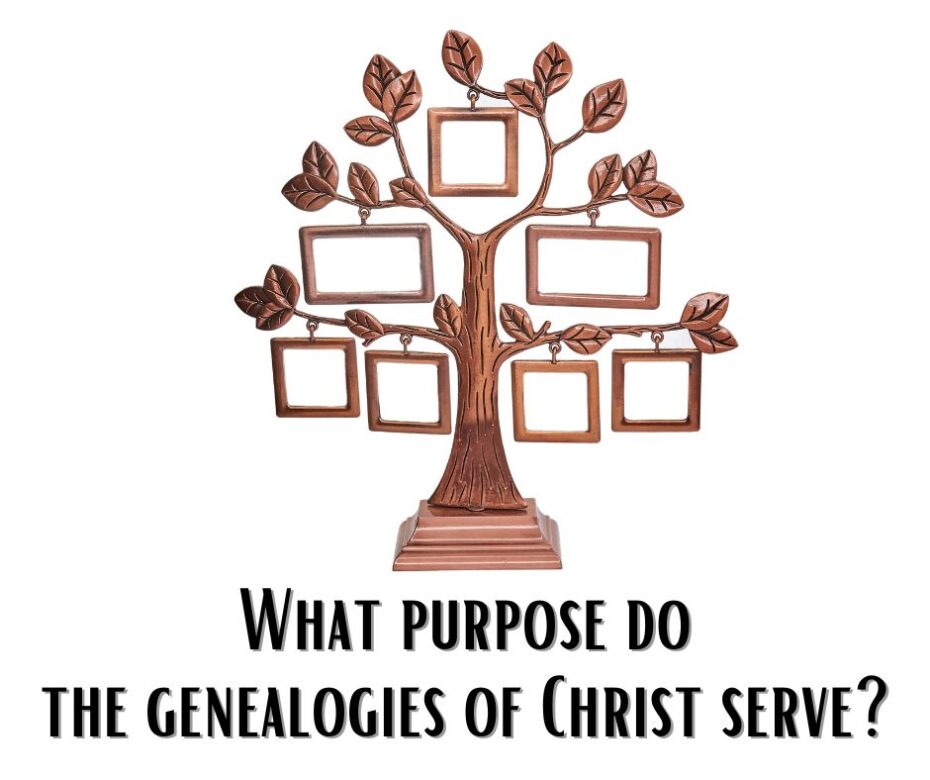Both Matthew (Matt 1:1-17) and Luke (3:23-38) include the genealogy of Christ in their Gospels. I’m pretty sure that most readers read over all those names fairly quickly, or even skip those verses all together. These verses have to win the prize for each book’s most boring section. We can’t even pronounce 80% of the names in them, and we have no idea who most of them were. They make Matthew and Luke look like what we get from our relatives who are really into ancestory.com and have traced our family trees back to the 1700s.
I also suspect that most of us see the purpose of these verses as nothing more than to tell us that Jesus was qualified to be the Messiah. He came from the right tribe and family and thus fulfilled prophecy. We probably think that both Matthew and Luke spent too much time–and wrote too many verses–in making that point.
But those of us who believe in the inspiration of the Scriptures should know better. There is more to these verses than meets the eye. Take, for example, Luke’s genealogy. It is crystal clear that he didn’t just throw this genealogy into his narrative. In the verse immediately before the genealogy, Luke records that at the baptism of Christ, the Father’s voice came out of heaven and said that Jesus was His “Son” (v 22). The genealogy begins with the statement that Jesus was supposedly the son of Joseph (v 23). The genealogy ends with Luke’s statement that Jesus was in a line that included the son of Adam, and that Adam was the son of God. The genealogy ends by taking us back to the baptism of Christ by means of the word son.
But the connection with Christ’s baptism is seen in another way at the beginning of the genealogy. Luke says that Jesus began His ministry at the age of thirty. But what was the beginning of that ministry? It happened at His baptism when the Spirit came upon Him and His Father announced His approval of His Son.
At His baptism, Jesus identified with John the Baptist’s message to the Nation of Israel. He identified with God’s chosen people. The Father’s words showed that He was both Israel’s King and the Suffering Servant of Isaiah. Christ was the promised Son of David. John had gone to the Nation of Israel and told the people to get ready for their King. This certainly was great news for the Jews of Jesus’ day.
But Luke was not writing to the Jewish people. He wrote his book for a man named Theophilus, who was almost certainly a Gentile (Luke 1:1-4). While Theophilus could read about these things and be glad for the Jews, what did they mean for him?
Matthew’s genealogy also emphasizes the Jewish nature of Christ’s ministry, tracing Jesus’ lineage all the way back to Abraham, the father of the Jewish nation. In the very first line of Matthew, Jesus is called the Son of David. He would be the Descendant of David who would rule over Israel forever, fulfilling the promise to the Jews in 2 Samuel 7.
But Luke doesn’t stop with Abraham. He goes farther and farther back into Christ’s lineage, ending with Adam. Like Theophilus, the Lord traced His ancestry back to the first man. All of us can claim Adam as our ancestor. That included Theophilus.
The placement of Luke’s genealogy immediately following the account of Christ’s baptism offered great and reassuring news to a Gentile like Theophilus. The King was not just identifying with the Jews; He identified with all mankind (Heb 2:14). As the King came up out of the water and the Father said He would suffer, it was not just for the Jews. He would suffer for all of us. He was not only going to be the King of the Jews. He would be the King for every believer, even Theophilus.
Our ancestor, Adam, blew it when he was tempted by Satan (Gen 3). Christ, the Second Adam, would be tempted by Satan, but He would overcome the evil one. Luke’s record of that temptation is placed immediately after his presentation of Christ’s genealogy, which ends with the statement that Adam was the son of God.
This genealogy would have been exciting stuff for a Gentile like Theophilus and other Gentiles who read it. The King comes out of the baptismal waters. The Father says He will suffer and die for His people to bring them life. But that includes us. We are told He is of us. He is our captain. Our King goes out to meet the one who tempted our ancestor and caused him to sin. The Second Adam will do all that is necessary to undo what Adam brought into the world.


